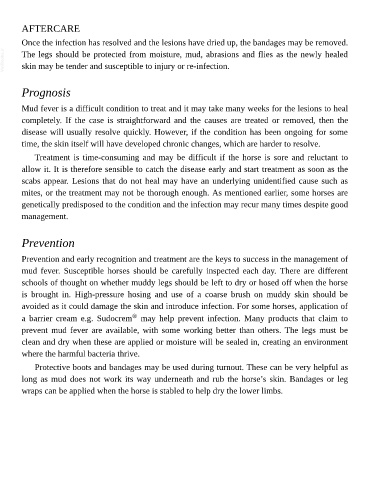Page 828 - The Veterinary Care of the Horse
P. 828
AFTERCARE
Once the infection has resolved and the lesions have dried up, the bandages may be removed.
VetBooks.ir The legs should be protected from moisture, mud, abrasions and flies as the newly healed
skin may be tender and susceptible to injury or re-infection.
Prognosis
Mud fever is a difficult condition to treat and it may take many weeks for the lesions to heal
completely. If the case is straightforward and the causes are treated or removed, then the
disease will usually resolve quickly. However, if the condition has been ongoing for some
time, the skin itself will have developed chronic changes, which are harder to resolve.
Treatment is time-consuming and may be difficult if the horse is sore and reluctant to
allow it. It is therefore sensible to catch the disease early and start treatment as soon as the
scabs appear. Lesions that do not heal may have an underlying unidentified cause such as
mites, or the treatment may not be thorough enough. As mentioned earlier, some horses are
genetically predisposed to the condition and the infection may recur many times despite good
management.
Prevention
Prevention and early recognition and treatment are the keys to success in the management of
mud fever. Susceptible horses should be carefully inspected each day. There are different
schools of thought on whether muddy legs should be left to dry or hosed off when the horse
is brought in. High-pressure hosing and use of a coarse brush on muddy skin should be
avoided as it could damage the skin and introduce infection. For some horses, application of
®
a barrier cream e.g. Sudocrem may help prevent infection. Many products that claim to
prevent mud fever are available, with some working better than others. The legs must be
clean and dry when these are applied or moisture will be sealed in, creating an environment
where the harmful bacteria thrive.
Protective boots and bandages may be used during turnout. These can be very helpful as
long as mud does not work its way underneath and rub the horse’s skin. Bandages or leg
wraps can be applied when the horse is stabled to help dry the lower limbs.

